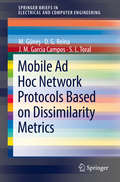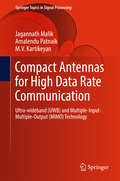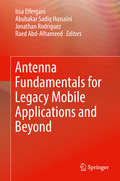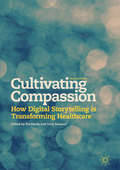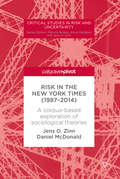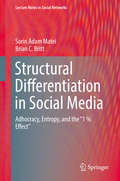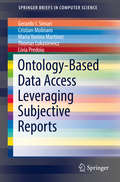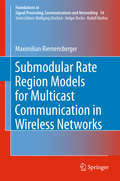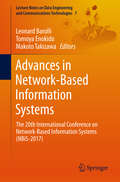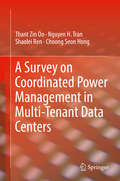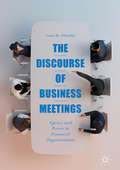- Table View
- List View
Network, Smart And Open: Three Keywords for Information Systems Innovation (PDF)
by Rita Lamboglia Andrea Cardoni Renata Paola Dameri Daniela ManciniThis book presents a collection of original research papers addressing the relationship between information systems (IS) and innovation. “Open”, “Smart” and “Network” are three keywords that are currently guiding information systems (IS) innovation, enhancing IS potentialities and their ability to support decision-making processes. The book discusses the relevance of these three new concepts in connection with technological and organizational innovations (i.e. cloud, smart technologies and networking), and the role they play in the development of accounting and management information systems. The book’s primary aim is to investigate how these innovations could influence information systems (with a particular focus on accounting and management information systems) by enhancing their information potentialities and improv ing accounting methodologies, performance measurement systems, data management, information systems architectures, and external and internal reporting. The book is based on a selection of the best papers―original double-blind reviewed contributions―presented at the 2016 Annual Conference of the Italian Chapter of the Association for Information Systems (AIS).
Intellectual Capital in German Non-profit Organisations: An Empirical Study (Contributions to Management Science)
by Katrin BlankenburgThis book describes how non-profit organisations (NPOs) communicate what they constitute, signal success and display sustainability in order to convince stakeholders to provide essential resources. Reports on intellectual capital offer a worthwhile approach. Based on empirical research, the book highlights the essential resources for NPOs and on the demand imposed on organisations, as well as the dependencies of those resources and demands. This insight helps NPOs to provide necessary information while keeping the disclosure to a minimum and thus not giving away possible competitive advantages. Further, the status-quo of IC disclosure in Germany is presented and a theoretical framework for the motivation for NPOs to disclose information on their IC is presented. Researchers will find these findings a solid foundation for further research. Finally, a framework for the disclosure of intellectual capital is provided to support practitioners.
Mobile Ad Hoc Network Protocols Based on Dissimilarity Metrics (SpringerBriefs in Electrical and Computer Engineering)
by M. Günes D. G. Reina J. M. Garcia Campos S. L. ToralThis SpringerBrief presents the design and performance evaluation of communication protocols based on dissimilarity metrics for wireless multihop networks. Dissimilarity metrics are used to infer the network topology based solely on local information to efficiently disseminate packets throughout the network, reducing both redundancy and congestion which is covered in this brief. The performance evaluation of the proposed communication protocols has been conducted by both meticulous simulation and real experimentation in a wireless multi-hop testbed. The obtained results in this brief corroborate the hypothesis regarding the validity of dissimilarity metrics, which can be used to design efficient communication protocols. This SpringerBrief is a good starting point for advanced-level students studying computer science and electrical engineering, as well as researchers and professionals working in this field.
The Rise of Populism in Western Europe: A Media Analysis on Failed Political Messaging
by Timo LochockiThis book explores the question of why and under which conditions right-wing populist parties receive electoral support. The author argues that neither economic variables, nor national culture or history are what account for their successes. Instead, he illustrates that the electoral success of populist parties in Western Europe, such as the French Front National or the Alternative for Germany, is best understood as the unintended consequence of misleading political messaging on the part of established political actors. A two-level theory explains why moderate politicians have changed their approaches to political messaging, potentially benefiting the nationalist, anti-elitist and anti-immigration rhetoric of their populist contenders. Lastly, the book’s theoretical assumptions are empirically validated by case studies on the immigration societies of Germany, the Netherlands and Sweden.
Advanced Optical and Wireless Communications Systems
by Ivan B. DjordjevicThis textbook introduces the advanced topics of: (i) wireless communications, (ii) free-space optical (FSO) communications, (iii) indoor optical wireless (IR) communications, and (iv) fiber-optics communications and presents these different types of communication systems in a unified fashion for better practical use. Fundamental concepts, such as propagation principles, modulation formats, channel coding, diversity principles, MIMO signal processing, multicarrier modulation, equalization, adaptive modulation and coding, detection principles, and software defined transmission are first described and then followed up with a detailed look at each particular system. The book is self-contained and structured to provide straightforward guidance to readers looking to capture fundamentals and gain theoretical and practical knowledge about wireless communications, optical communications, and fiber-optics communications, all which can be readily applied in studies, research, and practical applications. The textbook is intended for an upper undergraduate or graduate level course in optical communication. It features problems, an appendix with all background material needed, and homework.
Compact Antennas for High Data Rate Communication: Ultra-wideband (UWB) and Multiple-Input-Multiple-Output (MIMO) Technology (Springer Topics in Signal Processing #14)
by Jagannath Malik Amalendu Patnaik M. V. KartikeyanThis book discusses the development of promising technologies for compact antennas for high data-rate communications. It discusses and analyzes the design of compact ultra-wideband (UWB) and multiple input, multiple output (MIMO) antennas, providing essential know-how for designers, practicing engineers and scientists. These wireless communication technologies enable consumers to have convenient access to a wide range of services – anytime, anywhere. And the introduction of wireless mobile access points eliminates the limitations to communication imposed by geographical location. The Internet has allowed people to access and share information much more rapidly, but in order to achieve higher data rates with the limited available resources and imposed constraints, wireless communication technology needs to be pushed beyond the physical limits of the propagation channel. This book contributes to achieving this goal.
Conquering Digital Overload: Leadership strategies that build engaging work cultures
by Peter Thomson Mike Johnson J. Michael DevlinThis book examines the impact of the digital deluge on employees and organizations and sets out the leadership actions needed to create a corporate culture fit for the digital age.In the digital world executives are presented with exponentially more information than their predecessors were a generation ago – and yet we’re not exponentially more productive. Why? Because we’re using twenty-first century technology with a twentieth century mindset. Excessive working hours, email overload and invasion of private life are all symptoms of a working culture that has used technology to simply amplify old management processes rather than enable and refine newer, more productive ones.Instead of liberating us, technology has created a digital overload, accentuating the problems of presenteeism, unreasonable deadlines and management demands. Organizations need to stop using technology to turn up the volume and start using it to change the channel. Written by a unique team of experts, this edited collection covers leadership, corporate culture, technology, wellness and workplace design. It argues that digital overload is a problem of corporate culture and a failure of leadership. As such it takes leadership to fix it. Leaders who have the courage to explore alternative ways of working with technology, the enlightenment to give employees more freedom and control over their own lives, and the humility to live and demonstrate the new culture personally. Those who do this have the power to transform their organizations so they can ride the digital wave rather than be swamped by it.
Conquering Digital Overload: Leadership strategies that build engaging work cultures
by Peter Thomson Mike Johnson J. Michael DevlinThis book examines the impact of the digital deluge on employees and organizations and sets out the leadership actions needed to create a corporate culture fit for the digital age.In the digital world executives are presented with exponentially more information than their predecessors were a generation ago – and yet we’re not exponentially more productive. Why? Because we’re using twenty-first century technology with a twentieth century mindset. Excessive working hours, email overload and invasion of private life are all symptoms of a working culture that has used technology to simply amplify old management processes rather than enable and refine newer, more productive ones.Instead of liberating us, technology has created a digital overload, accentuating the problems of presenteeism, unreasonable deadlines and management demands. Organizations need to stop using technology to turn up the volume and start using it to change the channel. Written by a unique team of experts, this edited collection covers leadership, corporate culture, technology, wellness and workplace design. It argues that digital overload is a problem of corporate culture and a failure of leadership. As such it takes leadership to fix it. Leaders who have the courage to explore alternative ways of working with technology, the enlightenment to give employees more freedom and control over their own lives, and the humility to live and demonstrate the new culture personally. Those who do this have the power to transform their organizations so they can ride the digital wave rather than be swamped by it.
Antenna Fundamentals for Legacy Mobile Applications and Beyond
by Issa Elfergani Abubakar Sadiq Hussaini Jonathan Rodriguez Raed Abd-AlhameedThis book highlights technology trends and challenges that trace the evolution of antenna design, starting from 3rd generation phones and moving towards the latest release of LTE-A. The authors explore how the simple monopole and whip antenna from the GSM years have evolved towards what we have today, an antenna design that is compact, multi-band in nature and caters to multiple elements on the same patch to provide high throughput connectivity. The scope of the book targets a broad range of subjects, including the microstrip antenna, PIFA antenna, and the monopole antenna to be used for different applications over three different mobile generations. Beyond that, the authors take a step into the future and look at antenna requirements for 5G communications, which already has the 5G drive in place with prominent scenarios and use-cases emerging. They examine these, and put in place the challenges that lie ahead for antenna design, particularly in mm-Wave design. The book provides a reference for practicing engineers and under/post graduate students working in this field.
Intelligent Transportation Systems: 802.11-based Vehicular Communications
by Syed Faraz Hasan Nazmul Siddique Shyam ChakrabortyThis new edition continues to focus on the nuts and bolts of wireless network access for devices on board vehicles. It has been updated to reflect on the most recent trends in the broad domain of Intelligent Transport Systems. It covers 802.11ac – a recent standard that is very useful in context where a large amount of information is to be sent in a limited time window. The new edition includes a thorough revision of the 'Vehicular Communication: Issues and Standards' chapter, with new citations and a new subsection on security. The new edition also cites numerous fresh research works to give readers an updated overview of the field. An update on the time delay incurred by applications that always run in the background (Skype, etc) is also covered. The 'Future Directions and Research Ideas' chapter is also largely re-written. An entirely new chapter on D2D communication keeping in view the vehicular context has been added in this edition. This volume will be a useful addition to the libraries for both the students of wireless communication and those studying applied probability.
Cultivating Compassion: How Digital Storytelling Is Transforming Healthcare
by Pip Hardy Tony SumnerThis book explores how digital storytelling can catalyze change in healthcare. Edited by the co-founders of the award-winning Patient Voices Programme, the authors discuss various applications for this technique; from using digital storytelling as a reflective process, to the use of digital stories in augmenting quantitative data. Through six main sections this second edition covers areas including healthcare education, patient engagement, quality improvement and the use of digital storytelling research. The chapters illuminate how digital storytelling can lead to greater humanity, understanding and, ultimately, compassion. This collection will appeal to those involved in delivering, managing or receiving healthcare and healthcare education and research, as well as people interested in digital storytelling and participatory media.
Risk in The New York Times: A corpus-based exploration of sociological theories (Critical Studies in Risk and Uncertainty)
by Jens O. Zinn Daniel McDonaldThis book investigates to what extent claims of common social science risk theories such as risk society, governmentality, risk and culture, risk colonisation and culture of fear are reflected in linguistic changes in print news media. The authors provide a corpus-based investigation of risk words in The New York Times (1987-2014) and a case study of the health domain. The book presents results from an interdisciplinary enterprise which combines sociological risk theories with a systematic functional theory of language to conduct an empirical analysis of linguistic patterns and social change. It will be of interest to students and scholars interested in corpus linguistics and digital humanities, and social scientists looking for new research strategies to examine long term social change.
Resource Management for Heterogeneous Wireless Networks (SpringerBriefs in Electrical and Computer Engineering)
by Amila Tharaperiya Gamage Xuemin Sherman ShenThis book provides an in-depth discussion on how to efficiently manage resources of heterogeneous wireless networks and how to design resource allocation algorithms to suit real world conditions. Efficiently managing resources of the networks is more crucial now, than ever before, to meet users’ rapidly increasing demand for higher data rates, better quality-of-service (QoS) and seamless coverage. Some of the techniques that can be incorporated within heterogeneous wireless networks to achieve this objective are interworking of the networks, user multi-homing and device-to-device (D2D) communication. Designing resource allocation algorithms to suit real world conditions is also important, as the algorithms should be deployable and perform well in real networks. For example, two of the conditions considered in this book are resource allocation intervals of different networks are different and small cell base stations have limited computational capacity. To address the first condition, resource allocation algorithms for interworking systems are designed to allocate resources of different networks at different time-scales. To address the second condition, resource allocation algorithms are designed to be able to run at cloud computing servers. More of such conditions, algorithms designed to suit these conditions, modeling techniques for various networks and performance analysis of the algorithms are discussed in the book. This book concludes with a discussion on the future research directions on the related fields of study. Advanced-level students focused on communication and networking will use this book as a study guide. Researchers and experts in the fields of networking, converged networks, small-cell networks, resource management, and interference management, as well as consultants working in network planning and optimization and managers, executives and network architects working in the networking industry will also find this book useful as a reference.
Structural Differentiation in Social Media: Adhocracy, Entropy, and the "1 % Effect" (Lecture Notes in Social Networks)
by Sorin Adam Matei Brian C. BrittThis book explores community dynamics within social media. Using Wikipedia as an example, the volume explores communities that rely upon commons-based peer production. Fundamental theoretical principles spanning such domains as organizational configurations, leadership roles, and social evolutionary theory are developed. In the context of Wikipedia, these theories explain how a functional elite of highly productive editors has emerged and why they are responsible for a majority of the content. It explains how the elite shapes the project and how this group tends to become stable and increasingly influential over time. Wikipedia has developed a new and resilient social hierarchy, an adhocracy, which combines features of traditional and new, online, social organizations. The book presents a set of practical approaches for using these theories in real-world practice. This work fundamentally changes the way we think about social media leadership and evolution, emphasizing the crucial contributions of leadership, of elite social roles, and of group global structure to the overall success and stability of large social media projects. Written in an accessible and direct style, the book will be of interest to academics as well as professionals with an interest in social media and commons-based peer production processes.
Languages after Brexit: How the UK Speaks to the World
by Michael KellyThis book represents a significant intervention into the debates surrounding Brexit and language policy. It analyses the language capabilities and resources of the United Kingdom in a new, post-referendum climate, in which public hostility towards foreign languages is matched by the necessity of renegotiating and building relationships with the rest of Europe and beyond. The authors scrutinize the availability of key resources in diverse sectors of society including politics, economics, business, science and education, while simultaneously offering practical advice and guidance on how to thrive in the new international environment. This extremely timely edited collection brings together leading researchers from across the field of language policy, and is sure to appeal not only to students and scholars of this subject, but also to practitioners, policy makers and educators.
Languages after Brexit: How the UK Speaks to the World
by Michael KellyThis book represents a significant intervention into the debates surrounding Brexit and language policy. It analyses the language capabilities and resources of the United Kingdom in a new, post-referendum climate, in which public hostility towards foreign languages is matched by the necessity of renegotiating and building relationships with the rest of Europe and beyond. The authors scrutinize the availability of key resources in diverse sectors of society including politics, economics, business, science and education, while simultaneously offering practical advice and guidance on how to thrive in the new international environment. This extremely timely edited collection brings together leading researchers from across the field of language policy, and is sure to appeal not only to students and scholars of this subject, but also to practitioners, policy makers and educators.
Network Traffic Anomaly Detection and Prevention: Concepts, Techniques, and Tools (Computer Communications and Networks)
by Monowar H. Bhuyan Dhruba K. Bhattacharyya Jugal K. KalitaThis indispensable text/reference presents a comprehensive overview on the detection and prevention of anomalies in computer network traffic, from coverage of the fundamental theoretical concepts to in-depth analysis of systems and methods. Readers will benefit from invaluable practical guidance on how to design an intrusion detection technique and incorporate it into a system, as well as on how to analyze and correlate alerts without prior information.Topics and features: introduces the essentials of traffic management in high speed networks, detailing types of anomalies, network vulnerabilities, and a taxonomy of network attacks; describes a systematic approach to generating large network intrusion datasets, and reviews existing synthetic, benchmark, and real-life datasets; provides a detailed study of network anomaly detection techniques and systems under six different categories: statistical, classification, knowledge-base, cluster and outlier detection, soft computing, and combination learners; examines alert management and anomaly prevention techniques, including alert preprocessing, alert correlation, and alert post-processing; presents a hands-on approach to developing network traffic monitoring and analysis tools, together with a survey of existing tools; discusses various evaluation criteria and metrics, covering issues of accuracy, performance, completeness, timeliness, reliability, and quality; reviews open issues and challenges in network traffic anomaly detection and prevention.This informative work is ideal for graduate and advanced undergraduate students interested in network security and privacy, intrusion detection systems, and data mining in security. Researchers and practitioners specializing in network security will also find the book to be a useful reference.
Ontology-Based Data Access Leveraging Subjective Reports (SpringerBriefs in Computer Science)
by Gerardo I. Simari Cristian Molinaro Maria Vanina Martinez Thomas Lukasiewicz Livia PredoiuThis SpringerBrief reviews the knowledge engineering problem of engineering objectivity in top-k query answering; essentially, answers must be computed taking into account the user’s preferences and a collection of (subjective) reports provided by other users. Most assume each report can be seen as a set of scores for a list of features, its author’s preferences among the features, as well as other information is discussed in this brief. These pieces of information for every report are then combined, along with the querying user’s preferences and their trust in each report, to rank the query results. Everyday examples of this setup are the online reviews that can be found in sites like Amazon, Trip Advisor, and Yelp, among many others.Throughout this knowledge engineering effort the authors adopt the Datalog+/– family of ontology languages as the underlying knowledge representation and reasoning formalism, and investigate several alternative ways in which rankings can be derived, along with algorithms for top-k (atomic) query answering under these rankings. This SpringerBrief also investigate assumptions under which our algorithms run in polynomial time in the data complexity. Since this SpringerBrief contains a gentle introduction to the main building blocks (OBDA, Datalog+/-, and reasoning with preferences), it should be of value to students, researchers, and practitioners who are interested in the general problem of incorporating user preferences into related formalisms and tools. Practitioners also interested in using Ontology-based Data Access to leverage information contained in reviews of products and services for a better customer experience will be interested in this brief and researchers working in the areas of Ontological Languages, Semantic Web, Data Provenance, and Reasoning with Preferences.
Submodular Rate Region Models for Multicast Communication in Wireless Networks (Foundations in Signal Processing, Communications and Networking #14)
by Maximilian RiemensbergerThis book proposes representations of multicast rate regions in wireless networks based on the mathematical concept of submodular functions, e.g., the submodular cut model and the polymatroid broadcast model. These models subsume and generalize the graph and hypergraph models. The submodular structure facilitates a dual decomposition approach to network utility maximization problems, which exploits the greedy algorithm for linear programming on submodular polyhedra. This approach yields computationally efficient characterizations of inner and outer bounds on the multicast capacity regions for various classes of wireless networks.
Advances in Network-Based Information Systems: The 20th International Conference on Network-Based Information Systems (NBiS-2017) (Lecture Notes on Data Engineering and Communications Technologies #7)
by Leonard Barolli Tomoya Enokido Makoto TakizawaThis book highlights the latest research findings, innovative research results, methods and development techniques from both theoretical and practical perspectives related to the emerging areas of information networking and their applications. It includes the Proceedings of the 20th International Conference on Network-Based Information Systems (NBiS-2017), held on August 24–26, 2017 in Toronto, Canada.Today’s networks and information systems are evolving rapidly. Further, there are dynamic new trends and applications in information networking such as wireless sensor networks, ad hoc networks, peer-to-peer systems, vehicular networks, opportunistic networks, grid and cloud computing, pervasive and ubiquitous computing, multimedia systems, security, multi-agent systems, high-speed networks, and web-based systems. These networks are expected to manage the increasing number of users, provide support for a range of services, guarantee the quality of service (QoS), and optimize their network resources. In turn, these demands are the source of various research issues and challenges that have to be overcome – and which these Proceeding address.
Optimal Control of Energy Resources for State Estimation Over Wireless Channels (SpringerBriefs in Electrical and Computer Engineering)
by Alex S. Leong Daniel E. Quevedo Subhrakanti DeyThis brief introduces wireless communications ideas and techniques into the study of networked control systems. It focuses on state estimation problems in which sensor measurements (or related quantities) are transmitted over wireless links to a central observer. Wireless communications techniques are used for energy resource management in order to improve the performance of the estimator when transmission occurs over packet dropping links, taking energy use into account explicitly in Kalman filtering and control. The brief allows a reduction in the conservatism of control designs by taking advantage of the assumed. The brief shows how energy-harvesting-based rechargeable batteries or storage devices can offer significant advantages in the deployment of large-scale wireless sensor and actuator networks by avoiding the cost-prohibitive task of battery replacement and allowing self-sustaining sensor to be operation. In contrast with research on energy harvesting largely focused on resource allocation for wireless communication systems design, this brief optimizes estimation objectives such as minimizing the expected estimation error covariance. The resulting power control problems are often stochastic control problems which take into account both system and channel dynamics. The authors show how to pose and solve such design problems using dynamic programming techniques. Researchers and graduate students studying networked control systems will find this brief a helpful source of new ideas and research approaches.
MediaSync: Handbook on Multimedia Synchronization
by Mario Montagud Pablo Cesar Fernando Boronat Jack JansenThis book provides an approachable overview of the most recent advances in the fascinating field of media synchronization (mediasync), gathering contributions from the most representative and influential experts. Understanding the challenges of this field in the current multi-sensory, multi-device, and multi-protocol world is not an easy task. The book revisits the foundations of mediasync, including theoretical frameworks and models, highlights ongoing research efforts, like hybrid broadband broadcast (HBB) delivery and users’ perception modeling (i.e., Quality of Experience or QoE), and paves the way for the future (e.g., towards the deployment of multi-sensory and ultra-realistic experiences). Although many advances around mediasync have been devised and deployed, this area of research is getting renewed attention to overcome remaining challenges in the next-generation (heterogeneous and ubiquitous) media ecosystem. Given the significant advances in this research area, its current relevance and the multiple disciplines it involves, the availability of a reference book on mediasync becomes necessary. This book fills the gap in this context. In particular, it addresses key aspects and reviews the most relevant contributions within the mediasync research space, from different perspectives. Mediasync: Handbook on Multimedia Synchronization is the perfect companion for scholars and practitioners that want to acquire strong knowledge about this research area, and also approach the challenges behind ensuring the best mediated experiences, by providing the adequate synchronization between the media elements that constitute these experiences.
A Survey on Coordinated Power Management in Multi-Tenant Data Centers
by Thant Zin Oo Nguyen H. Tran Shaolei Ren Choong Seon HongThis book investigates the coordinated power management of multi-tenant data centers that account for a large portion of the data center industry. The authors include discussion of their quick growth and their electricity consumption, which has huge economic and environmental impacts. This book covers the various coordinated management solutions in the existing literature focusing on efficiency, sustainability, and demand response aspects. First, the authors provide a background on the multi-tenant data center covering the stake holders, components, power infrastructure, and energy usage. Then, each power management mechanism is described in terms of motivation, problem formulation, challenges and solution.
The Discourse of Business Meetings: Agency and Power in Financial Organizations
by Fatma M. AlHaidariThis book examines the social organizational discourse of task-oriented business meetings in a Kuwaiti financial organization and an American non-profit trade organisation. Focusing primarily on the linguistic behaviours demonstrating agency and power of managers and staff members displayed during these meetings, the project is based on ethnographic data collected during eight months of fieldwork. The author examines the similarities and differences between the linguistic behaviours of both organizations, particularly relating to the production of collective “we,” “us,” and “our” utterances and directive speech acts issued to explore how managers and co-workers perform agency and power in meetings. This distinctive book will shed light into the influence of language on the actions and relationships of managers and co-workers in business meetings, and will be of interest to applied linguists and discourse analysts in the field of business discourse in addition to business professionals in management and finance.
The Discourse of Business Meetings: Agency and Power in Financial Organizations
by Fatma M. AlHaidariThis book examines the social organizational discourse of task-oriented business meetings in a Kuwaiti financial organization and an American non-profit trade organisation. Focusing primarily on the linguistic behaviours demonstrating agency and power of managers and staff members displayed during these meetings, the project is based on ethnographic data collected during eight months of fieldwork. The author examines the similarities and differences between the linguistic behaviours of both organizations, particularly relating to the production of collective “we,” “us,” and “our” utterances and directive speech acts issued to explore how managers and co-workers perform agency and power in meetings. This distinctive book will shed light into the influence of language on the actions and relationships of managers and co-workers in business meetings, and will be of interest to applied linguists and discourse analysts in the field of business discourse in addition to business professionals in management and finance.


